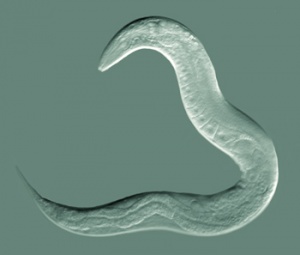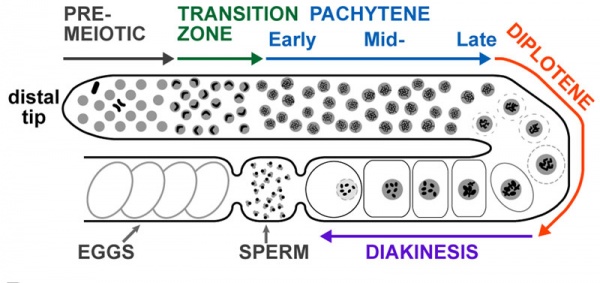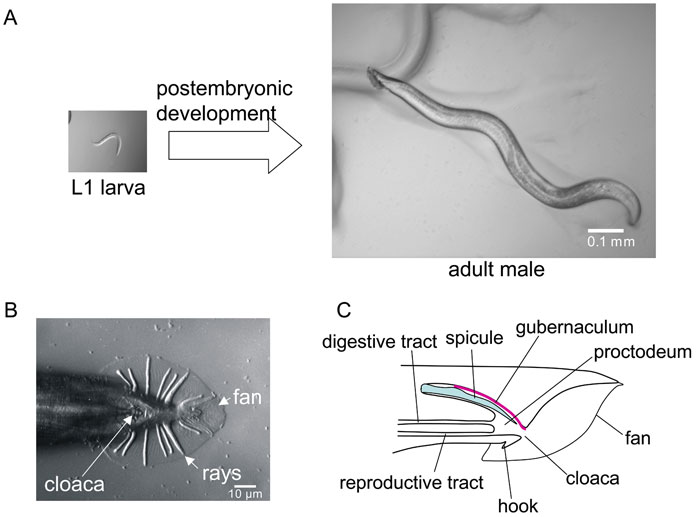Worm Development: Difference between revisions
| Line 42: | Line 42: | ||
[[File:Worm_-_embryonic_cell_lineage_02.jpg]] | [[File:Worm_-_embryonic_cell_lineage_02.jpg]] | ||
The overview diagram above shows the fate of each individual cell in the developing c. elegans. | |||
Note the image is not at a readable resolution, to view see [[:File:Worm_-_embryonic_cell_lineage_01.jpg|large readable version]] | |||
==References== | ==References== | ||
Revision as of 05:49, 7 November 2010
Introduction
Initially used in the 1960's by Sydney Brenner to study the genetics of development and neurobiology. Early embryological studies of the nematode worm (roundworm) Caenorhabditis elegans (C.Elegans, so called because of its "elegant" curving movement) characterized the fate of each and every cell in the worm through all stages of development. This worm was the first to have its entire genome sequenced and also used recently in space experiments (see below).
The USA space shuttle Atlantis in November 2009 launched Caenorhabditis elegans into space as part of an experiment to study RNA interference and protein phosphorylation in a space environment.
- "RNA interference and protein phosphorylation in space environment using the nematode Caenorhabditis elegans (CERISE) is an experiment that addresses two scientific objectives. The first is to evaluate the effect of microgravity on ribonucleic acid (RNA) interference. The second is to study how the space environment effects protein phosphorylation (addition of a phosphate molecule) and signal transduction in the muscle fibers of gene knock-downed Caenorhabditis elegans."
- Links: original page
Some Recent Findings
|
Adult Anatomy
Adult Hermaphrodite Gonad
Adult hermaphrodite gonad arm[2] - A drawing representation of an adult hermaphrodite gonad arm. The progression of germ cell proliferation and meiosis are indicated by the arrows starting from the distal tip region of the gonad arm.
Male Development
The features that differentiate the C. elegans male from the hermaphrodite arise during postembryonic development.[3]
RNA interference
The two researchers, Andrew Z. Fire and Craig C. Mello[4], were investigating how gene expression is regulated in C. elegans and identified the novel regulation method of RNA interference (RNAi), gene silencing by double-stranded RNA. This discovery was awarded the 2006 Nobel Prize in Physiology or Medicine.
- Links: 2006 Nobel Press Release
Embryonic Cell Lineages
The overview diagram above shows the fate of each individual cell in the developing c. elegans.
Note the image is not at a readable resolution, to view see large readable version
References
- ↑ <pubmed>20232378</pubmed>
- ↑ <pubmed>20661436</pubmed>| PLoS Genetics
- ↑ <pubmed>18050419</pubmed> Worm Book - Male development
- ↑ <pubmed>12857879</pubmed>| PMC165691
Reviews
WormBook - a comprehensive, open-access collection of original, peer-reviewed chapters covering topics related to the biology of Caenorhabditis elegans and other nematodes.
- Asymmetric cell division and axis formation in the embryo
- Embryological variation during nematode development
Articles
Search Pubmed
July 2010 "c elegans Development" All (5126) Review (898) Free Full Text (2363)
Search Pubmed: Worm Development | Caenorhabditis elegans Development | c elegans Development
External Links
- WormBook open-access collection of chapters covering topics related to the biology of Caenorhabditis elegans (C. elegans) and other nematodes.
- Caenorhabditis Genome Sequencing Projects
- Caenorhabditis elegans WWW Server
- The Hall lab - aim to serve the C. elegans community by creating a digital database of TEM images & wild type tissues- an Atlas of worm anatomy.
| Animal Development: axolotl | bat | cat | chicken | cow | dog | dolphin | echidna | fly | frog | goat | grasshopper | guinea pig | hamster | horse | kangaroo | koala | lizard | medaka | mouse | opossum | pig | platypus | rabbit | rat | salamander | sea squirt | sea urchin | sheep | worm | zebrafish | life cycles | development timetable | development models | K12 |
Glossary Links
- Glossary: A | B | C | D | E | F | G | H | I | J | K | L | M | N | O | P | Q | R | S | T | U | V | W | X | Y | Z | Numbers | Symbols | Term Link
Cite this page: Hill, M.A. (2024, April 30) Embryology Worm Development. Retrieved from https://embryology.med.unsw.edu.au/embryology/index.php/Worm_Development
- © Dr Mark Hill 2024, UNSW Embryology ISBN: 978 0 7334 2609 4 - UNSW CRICOS Provider Code No. 00098G




